So you’re avoiding safflower oil? Then what is a good safflower oil substitute?
Let’s explore safflower oil, a common substitute for fats.
What is Safflower Oil?
Safflower oil is an oil extracted from safflower plants, common relatives of sunflowers.
Safflowers have several uses both in and out of the kitchen.
They are often used for their orange dye in both beauty and fabric, but also can be extracted for their oil.
Most grocery stores carry this popular edible oil.
Like most vegetable oils, safflower oil goes through extensive processing to turn it into its oil form.
This results in a loss of nutrients from the original plant.
It also changes the chemical composition of the oil, making for a less nutrient dense substance.
There are two types of safflower oil, high-linoleic and high-oleic.
Linoleic is higher in polyunsaturated fats due to its omega-6 fatty acids while oleic is higher in saturated fats.
This gives them both different uses in the kitchen.
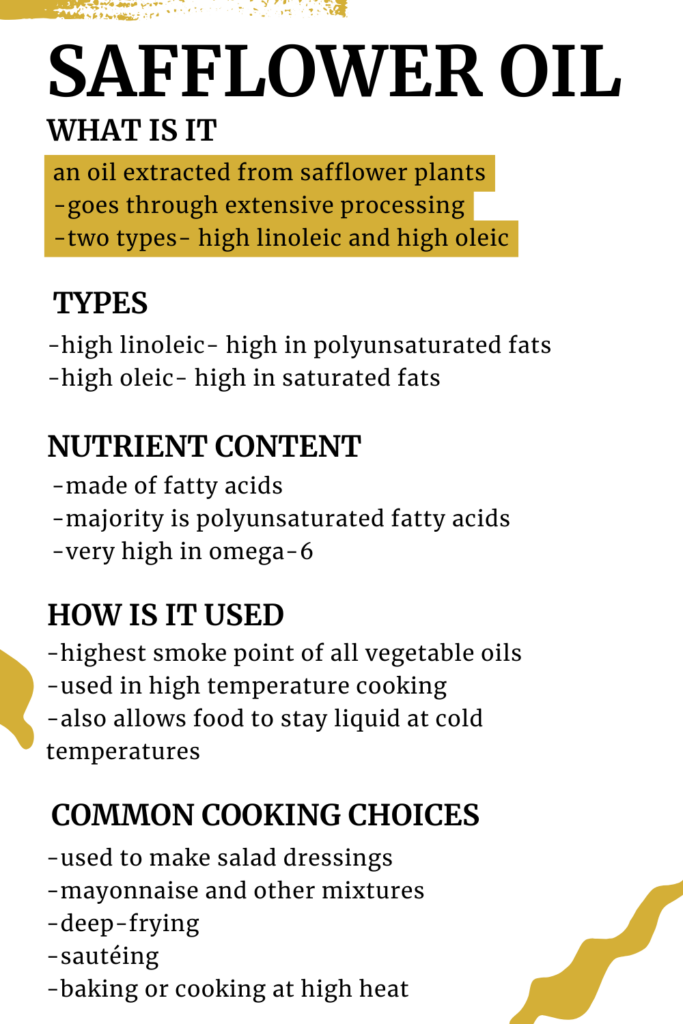
What is in Safflower Oil?
Like most vegetable oils, safflower oil is made of fatty acids.
Oleic and linoleic acid make up almost of all the oil, with a combined 87%.
75% of the oil is linoleic acid, which is an omega-6 fatty acid.
Oleic acid, a monounsaturated fat, makes up the other 12%.
The rest is made of two other fatty acids, palmitic and stearic acid.
These acids are both saturated fatty acids, and account for the remaining percentage. Although saturated fats do get a negative reputation they can actually be beneficial in small amounts, such as here.
High-oleic safflower oil contains the same proportions of oleic and linoleic acid, but switches which one dominates.
Oleic acid makes up 75% of this oil while linoleic only is 12%.
They both have different uses in the kitchen and slightly different properties due to the changes in their molecular structure.
How is Safflower Oil Used?
Safflower oil has the highest concentration of polyunsaturated fats of all the vegetable oils, which gives it the highest smoke point.
This means that it can be heated to extreme temperatures and also stays liquid at colder temperatures.
Because of these properties safflower oil is often used in mixtures for salad dressings and other cold foods. It allows them to retain their liquid form despite being refrigerated.
Because of its high smoking point, safflower oil is often used for deep frying and sautéing.
It has a 450 F smoke point, which is much higher than other oils. When frying, turn to higher oleic content which further increases the smoke point.
This oil also has a neutral flavor, which is one of its best selling points.
It is commonly used in baked goods or is perfect when trying to season without the pronounced oil flavor.
What is the Importance of a Smoke Point?
A smoke point is the temperature in which a substance starts breaking down and releases free radicals.
These radicals react with oxygen to form a substance that can be dangerous to inhale.
Radicals can damage cellular tissue and even your own DNA.
Knowing the properties of the oil you are working with can help to prevent the release of these chemicals.
To avoid reaching smoke point when cooking:
- know around what temperature the oil you are cooking with starts to smoke
- sautéing- pick any oil that has a medium smoke point or above, the oil does not have to be super hot to work
- deep-frying- use a thermometer and an oil that has a high smoke point
- stir-frying- use an oil with an extremely high smoke point, such as safflower oil
Benefits of Safflower Oil
Note: To be clear, I do NOT think there are truly benefits for using safflower oil when it comes to your gut health. Like soybean oil, safflower oil is often extracted with hexane and is high in omega-6 fats.
That being said, some will at least want the other side of the negatives. This would be that.
Safflower oil is recommended by the American Heart Association as one of the best substitutes to saturated fats, due to its chemical makeup.
It is claimed to help lower cholesterol, reduce cardiovascular diseases, and prevent hypertension.
All of these are common issues associated with a high consumption of saturated fats.
Other claims for health benefits include lowering blood pressure and increasing blood flow to the heart.
Safflower oil also contains a solid amount of vitamin E, which can act as an antioxidant in the body. This prevents cell damage by oxygen exposure. Vitamin E has also been shown to play a critical role in immune function.
Although it still does have health benefits, many other oils have been proven to be much more healthy oils, such as olive and coconut oil.
Drawbacks of Safflower Oil
Safflower oil is one of the vegetable oils that is extremely high in omega-6 fatty acids, which is not a bad thing at base level.
However its high content of linoleic acid (omega-6) promotes inflammation of tissue in the body.
Omega-6 fatty acids are correlated with increased inflammation, while omega-3 fatty acids tend to decrease the inflammation.
The unbalanced amounts of these acids causes inflammatory effects across the body.
Since high-oleic safflower oil contains less omega-6 fatty acids, it is slightly less inflammatory, but will have the same effects when consumed in excess.
Safflower Oil and Gut Health: What You Need to Know
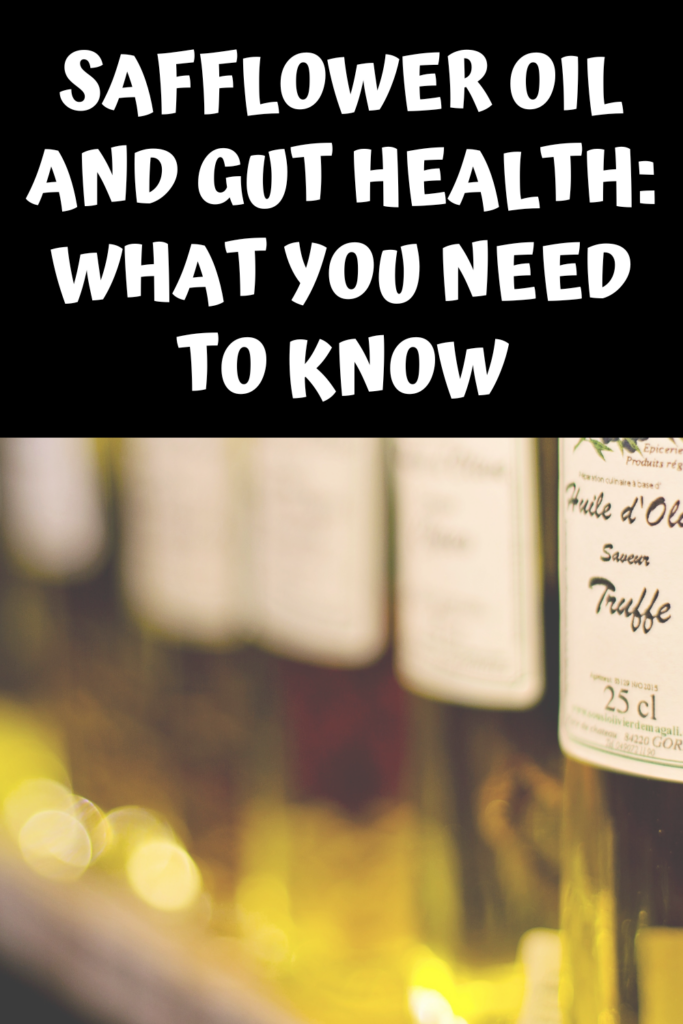
Safflower oil, particularly the high-linoleic variety, can be problematic for gut health for several key reasons:
1. Extreme Omega-6 to Omega-3 Imbalance
Safflower oil contains one of the highest concentrations of omega-6 fatty acids among all cooking oils, with very little omega-3 fatty acids to balance it.
The standard Western diet already provides far more omega-6 than necessary, often in ratios of 15:1 or higher (omega-6 to omega-3), while the ideal ratio is closer to 4:1 or even 1:1.
Research published in the Journal of Nutritional Biochemistry shows this imbalance can significantly alter gut microbiota composition, reducing beneficial bacterial diversity and promoting the growth of pro-inflammatory bacteria.
Sources: HERE, HERE, HERE, HERE, and HERE
2. Promotion of Intestinal Permeability (“Leaky Gut”)
Excessive omega-6 fatty acids, particularly linoleic acid which comprises up to 75% of standard safflower oil, have been linked to increased intestinal permeability.
A study in the Journal of Lipid Research demonstrated that high dietary linoleic acid can disrupt tight junctions between intestinal cells, allowing bacterial components and undigested food particles to enter the bloodstream, triggering immune responses and systemic inflammation.
3. Inflammatory Metabolites
When consumed, linoleic acid is converted into arachidonic acid, which serves as a precursor for pro-inflammatory molecules called eicosanoids.
These compounds, including prostaglandins and leukotrienes, can promote inflammation throughout the digestive tract and beyond.
Research in the American Journal of Clinical Nutrition has associated elevated dietary intake of linoleic acid with increased inflammatory markers in the gut.
4. Processing Concerns
Most commercially available safflower oil undergoes extensive processing, including:
- Extraction using chemical solvents like hexane
- Deodorization at high temperatures
- Bleaching and refining
These processes can create harmful compounds such as trans fats and oxidized lipids that may damage the gut lining and disrupt microbiome balance, according to findings published in Food and Chemical Toxicology.
Scientific Evidence Linking Omega-6 Overconsumption to Gut Inflammation
The scientific evidence connecting excessive omega-6 consumption to gut inflammation and digestive disorders has grown substantially:
- A 2020 study in Gut Microbes demonstrated that diets high in linoleic acid significantly altered intestinal microbiota, decreasing beneficial Bifidobacterium while increasing pathogenic bacteria associated with inflammatory bowel conditions.
- Research published in Frontiers in Immunology found that excessive dietary omega-6 fatty acids increased the production of IL-17, a pro-inflammatory cytokine strongly associated with inflammatory bowel disease and other autoimmune conditions affecting the gut.
- A comprehensive review in the Journal of Nutrition and Metabolism analyzed multiple studies and concluded that the shift toward vegetable oils high in omega-6, like safflower oil, correlates strongly with the rising incidence of inflammatory bowel diseases in Western countries since the 1950s.
- Laboratory studies in Cell Metabolism revealed that mice fed diets high in linoleic acid developed altered gut barrier function and increased intestinal inflammation, even in the absence of other dietary changes.
- Human clinical research published in Gastroenterology showed that individuals with inflammatory bowel disease who reduced their omega-6 intake while increasing omega-3 consumption experienced significant reductions in inflammatory markers and symptomatic improvement.
Sources: HERE, HERE, HERE, HERE, and HERE
Safflower Oil Substitute
Click HERE to save this article on safflower oil substitute for later.
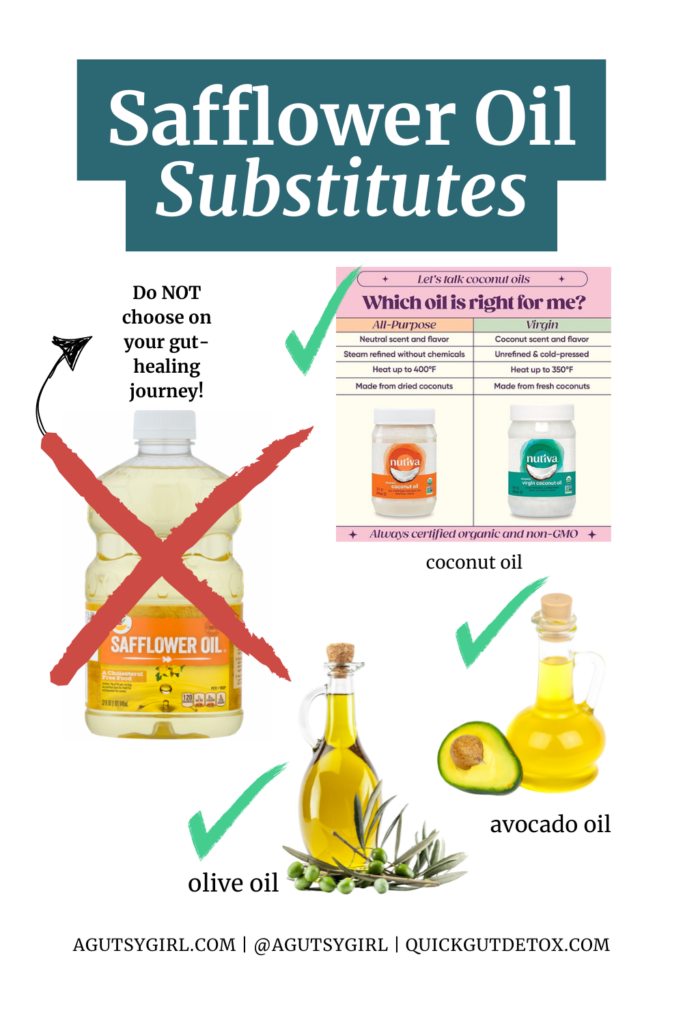
Finding an oil replacement is super easy and all of them can be swapped for one another in most circumstances.
Note: many sources will tell you to swap safflower oil with oils like: canola oil, sunflower oil, peanut oil, or another type of vegetable oil as such. Don’t!
You just need keep safflower oil’s special properties in mind when cooking at extremely high temperatures.
The other oils can not withstand that kind of heat.
The best substitute for safflower oil would be a vegetable oil with a neutral taste. However, for me personally, it’s more important that I find a great substitute regardless if it has a neutral taste or note.
Here are the 3 options I would choose from:
- Olive Oil
- Smoke point: varies, but generally falls between 374°F and 450°F (190°C and 232°C)
- More pronounced flavor, but still very versatile
- Avocado Oil
- Smoke point: ranging from 510 to 520 degrees Fahrenheit, avocado oil has the highest smoke point of plant-based cooking oils
- Rich and nutty, but generally neutral for swapping in and out of recipes
- Coconut Oil
- Smoke point: With a higher smoke point than the Organic Virgin Coconut Oil, 400 degrees F, Nutiva’s Organic All-Purpose Coconut Oil is extremely versatile and can be used as an alternative to butter and other vegetable oils. [350 degrees F is best for their Organic Coconut Oil]
- If I want a neutral flavor I’ll choose Nutiva’s Organic All-Purpose Coconut Oil. I prefer the taste of the Organic Coconut Oil, as I love the tropical twist!
Nutritional Comparison of Cooking Oils (per 1 tablespoon/14g)
| Nutrient | Safflower Oil | Coconut Oil | Avocado Oil | Olive Oil |
|---|---|---|---|---|
| Calories | 120 | 120 | 124 | 119 |
| Total Fat | 14g | 14g | 14g | 14g |
| Saturated Fat | 1-2g (high-oleic: 1g, high-linoleic: 0.8g) | 12-13g | 1.6g | 1.9g |
| Monounsaturated Fat | High-oleic: 10.5g, High-linoleic: 1.7g | 0.8g | 9.9g | 9.9-10.5g |
| Polyunsaturated Fat | High-oleic: 1.7g, High-linoleic: 10.5g | 0.2g | 1.9g | 1.4g |
| Omega-6 to Omega-3 Ratio | Very high (mostly omega-6) | Low | Moderate | Low to moderate (3:1 to 13:1) |
| Vitamin E | 4.6mg (31% DV) | 0.1mg (<1% DV) | 2.7mg (18% DV) | 1.9mg (13% DV) |
| Vitamin K | Trace | Trace | Trace | 8.1μg (10% DV) |
| Smoke Point | 450-510°F (232-265°C) | 350-400°F (175-204°C) | 520°F (270°C) | Extra virgin: 375°F (190°C), Light: 465°F (240°C) |
| Processing Level | Highly processed | Minimally processed | Minimally processed | Minimally processed (especially extra virgin) |
| Flavor Profile | Neutral | Distinct coconut flavor (unrefined) | Mild, slightly nutty | Distinct olive flavor (more pronounced in extra virgin) |
| Gut Health Impact | Potentially negative due to high omega-6 content | Generally positive due to MCTs | Generally positive | Generally positive, contains beneficial polyphenols |
| Storage Stability | High stability when refined | Very stable, solid at room temperature | Very stable | Moderate stability (extra virgin less stable than refined) |
So… To Eat or Not to Eat?
Despite safflower’s proclaimed “health benefits” I truly believe the negatives outweigh them.
I do think safflower oil is a great option for any sort of high heat cooking, but aside from that you can find a healthier option.
If you need a neutral oil, you can use safflower oil in small amounts, but be careful not to overdo it. This can cause inflammation and negative side effects.
I would recommend turning to one of my alternatives above.
These oils have not been shown to have the inflammatory properties of safflower oil and are just as effective in cooking.
Although some may have a lower smoke point, in many recipes this will not make that big of a difference.
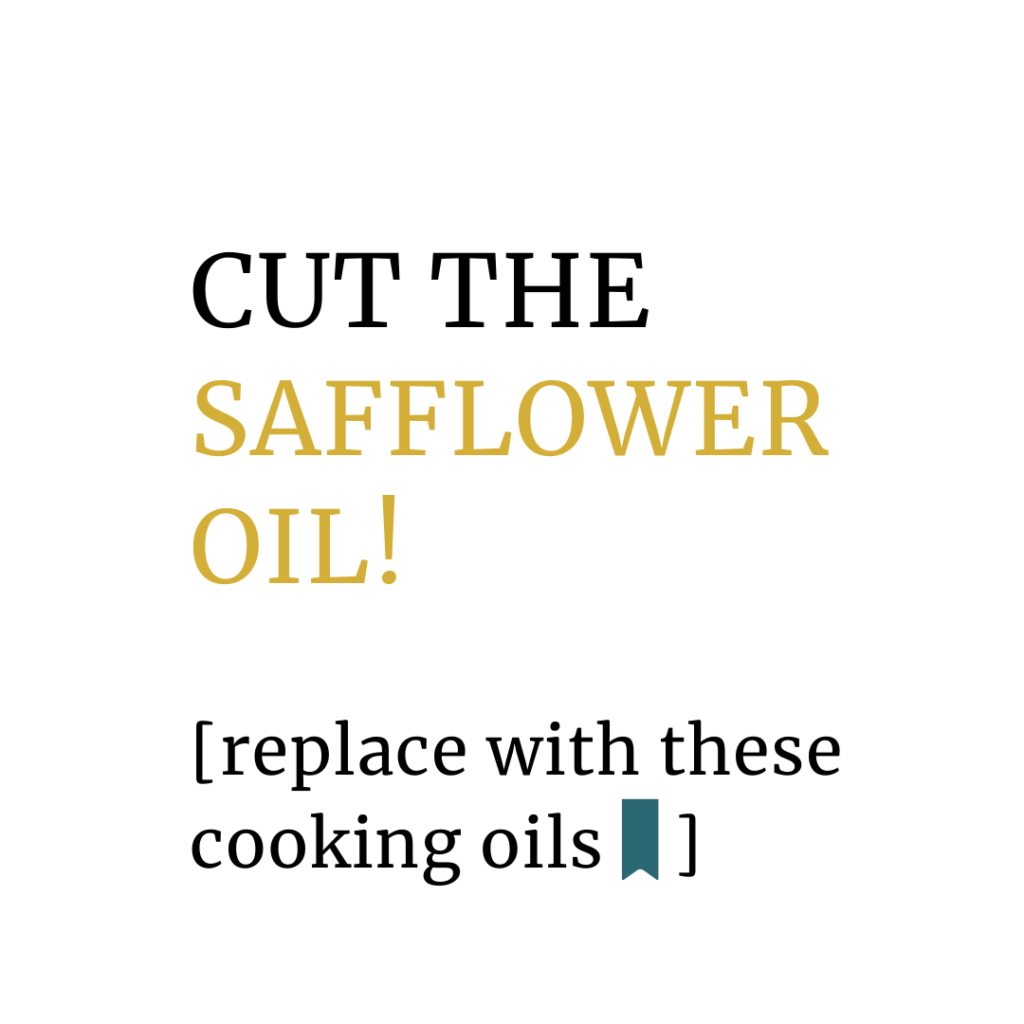
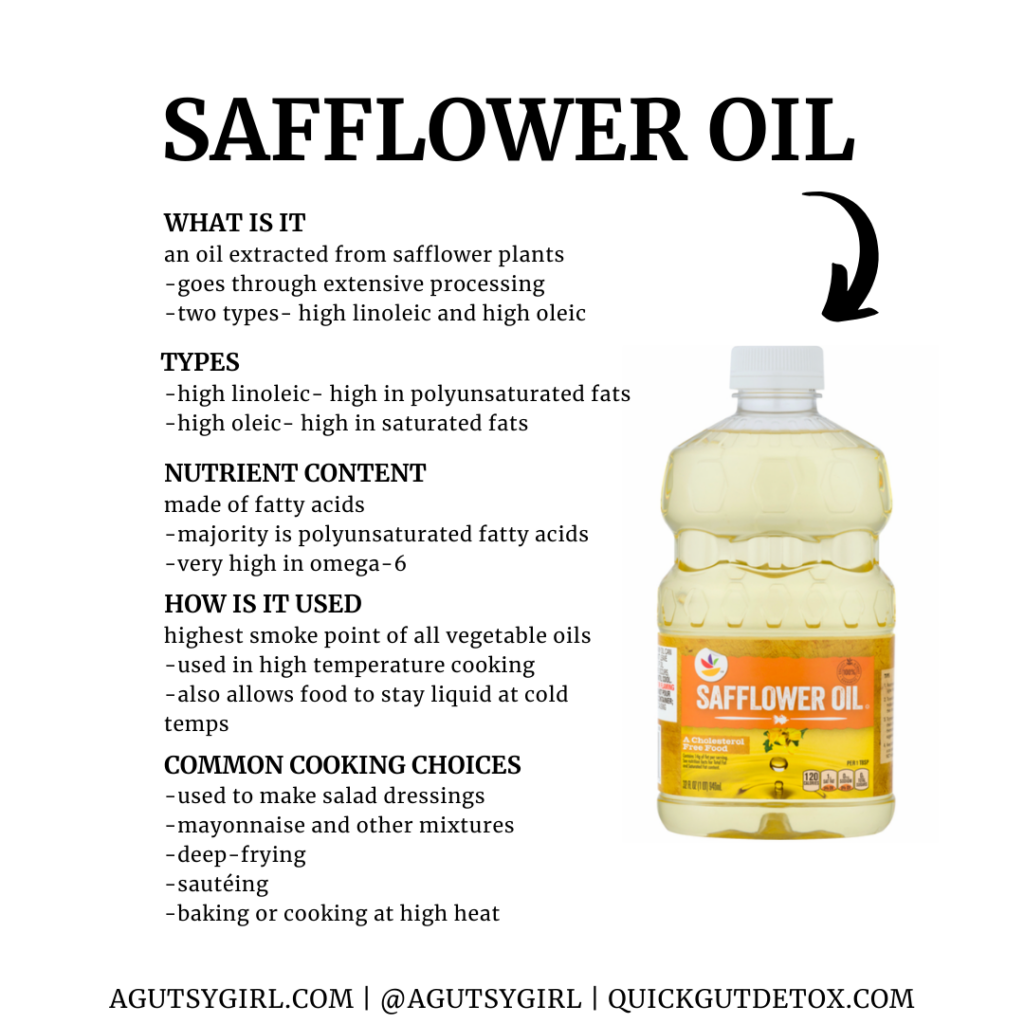
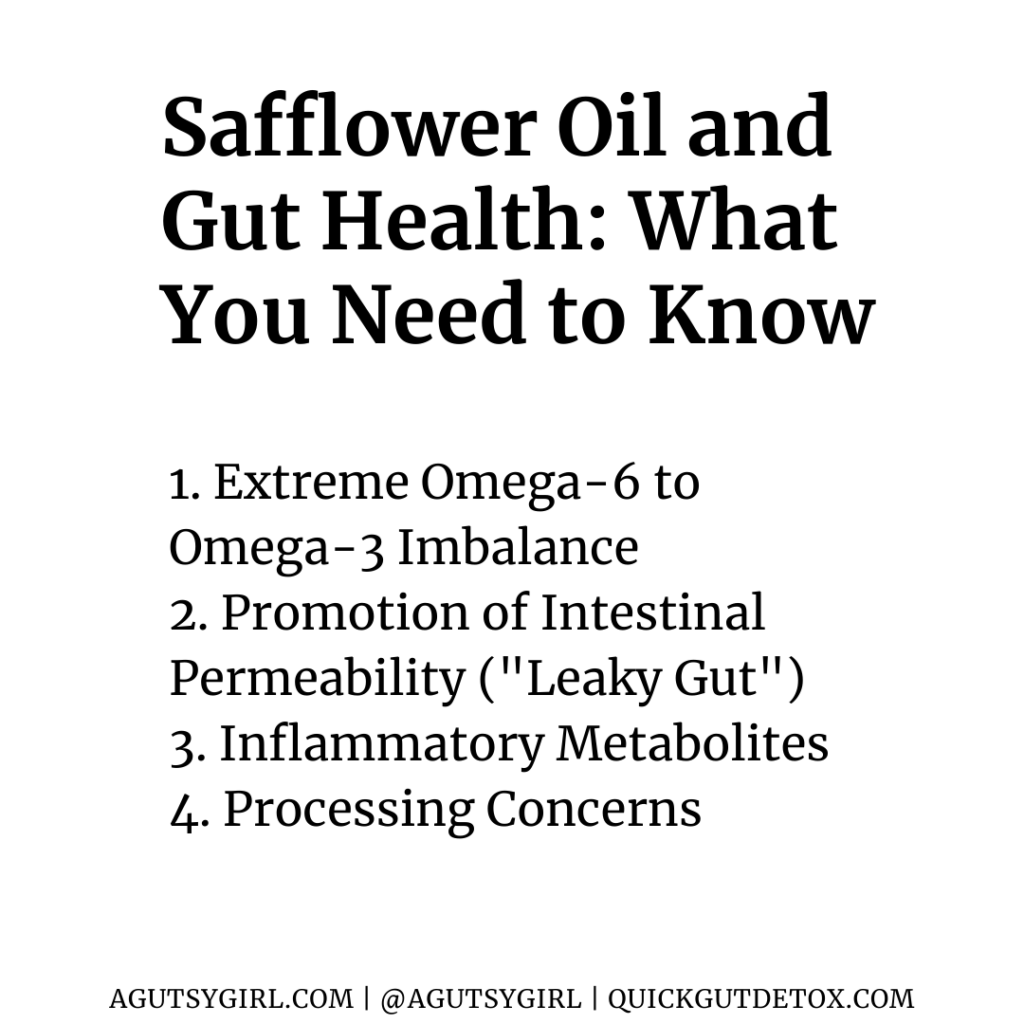

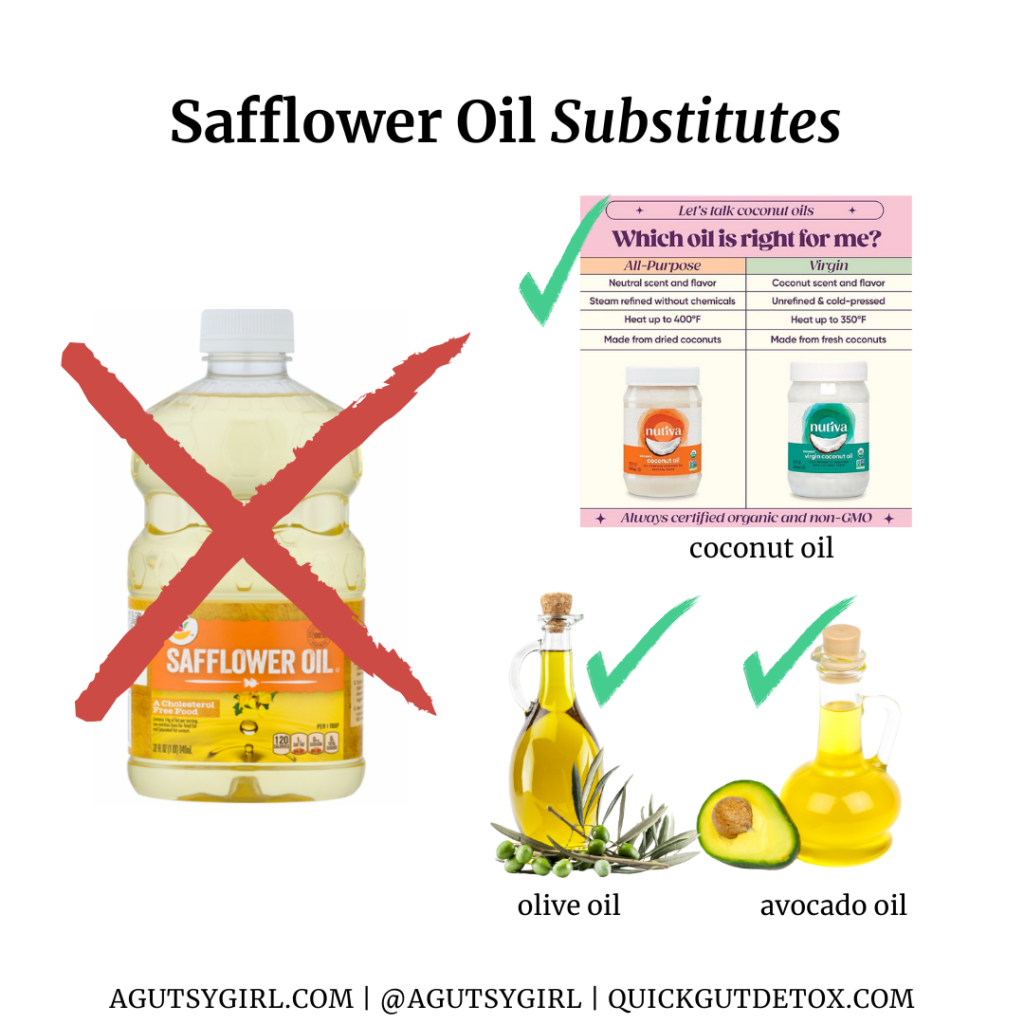
Conclusion: Making Informed Choices for Your Gut Health
The relationship between dietary oils and gut health represents one of the most overlooked aspects of modern nutrition.
As we’ve explored throughout this article, the overconsumption of linoleic acid-rich safflower oil presents significant concerns for digestive wellbeing—from disrupting the delicate balance of gut microbiota to potentially contributing to intestinal permeability and chronic inflammation.
The good news is that simple dietary shifts – and a safflower oil substitute – can make a profound difference.
By replacing safflower oil with gut-friendly alternatives like olive, avocado, or coconut oil, you’re not just avoiding potential harm—you’re actively supporting your digestive ecosystem with beneficial compounds that nourish your microbiome and protect intestinal integrity.
Remember that gut health isn’t isolated—it’s connected to virtually every system in your body, from immune function to mental wellbeing.
The oils you choose for daily cooking might seem like a small decision, but their cumulative impact on your health can be substantial.
Every meal presents an opportunity to either support or challenge your gut health.
Next time you’re at the grocery store, take a moment in the oil aisle to consider not just the cooking properties of your oils, but their impact on your gut microbiome and long-term health.
Your digestive system works tirelessly to support you—returning the favor with high-quality, anti-inflammatory oils is one of the most impactful dietary choices you can make.
If you liked this article on safflower, you might also enjoy:
Xox,
SKH
🤰 bloating be gone! weight loss through optimal gut health for women
💃ʜᴇᴀʟ ʏᴏᴜʀ ɢᴜᴛ. ʜᴇᴀʟ ʏᴏᴜʀ ʟɪfe.
🫶🏻 founder gutbyome.com







